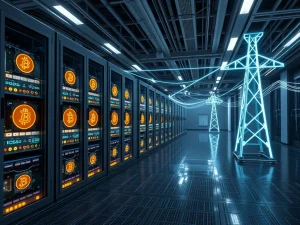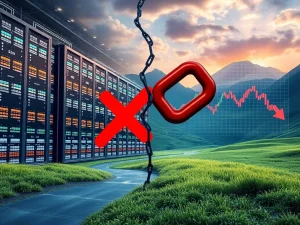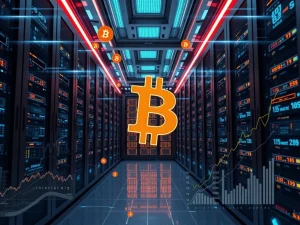Solo Bitcoin Miners: 5 Unbelievable Wins Exceeding $350K Each in 2025

In the dynamic world of cryptocurrency, **solo Bitcoin miners** often face monumental odds. Indeed, the landscape of **Bitcoin mining** is largely dominated by colossal mining farms. These operations are equipped with cutting-edge, specialized hardware. However, 2025 delivered an astonishing series of events. Five independent miners, operating outside the realm of massive mining pools, achieved remarkable **solo mining success**. Each successfully mined a block, securing **Bitcoin block rewards** exceeding $350,000. These victories, while rare, vividly underscore the unpredictable and decentralized nature of Bitcoin. They show that even small-scale participants can occasionally outshine corporate giants in the competitive arena of **crypto mining**.
The Challenge of Solo Bitcoin Mining in 2025
Mining Bitcoin involves validating transactions and securing the network. This process requires solving complex cryptographic puzzles. Historically, large-scale mining farms dominate this activity. They possess specialized hardware, making solo mining an exceedingly rare feat. A lone individual attempting to discover a block faces significant hurdles. In 2025, the mining difficulty reached an all-time high. Consequently, a solo miner using standard hardware had a probability of success comparable to winning a major lottery. The Bitcoin network’s total hash rate consistently increased. Therefore, the chance of a small-scale miner, with only a few terahashes per second (TH/s), successfully mining a block became exceptionally low. For instance, a miner with a 100-TH/s machine, like a high-end Antminer S19, had less than a 0.0001% chance of solving a block daily. As a result, a solo miner could wait months or even years to earn a single block reward. This context highlights the extraordinary nature of the 2025 solo wins.
Did you know? Satoshi Nakamoto launched Bitcoin mining with the “genesis block” on Jan. 3, 2009. That first block awarded 50 BTC as the mining reward. Every miner since has built on that foundational proof-of-work legacy.
Unpacking Five Remarkable Solo Mining Successes
Each **solo Bitcoin miner** who succeeded in 2025 solved a block independently. They earned **Bitcoin block rewards** valued at around $350,000. This achievement is nearly unprecedented in Bitcoin’s competitive mining environment. Let’s look at these specific, groundbreaking instances:
- Block 883,181 (Feb. 10, 2025): An independent miner successfully mined this block. They received a reward of 3.125 BTC, valued at over $300,000 at the time. This anonymous miner secured block 883,181, which processed 3,071 transactions. The block yielded a total reward of 3.15 BTC.
- Block 903,883 (July 4, 2025): On this date, a solo miner with only 2.3 petahashes per second (PH/s) mined block 903,883. They received 3.173 BTC, approximately $349,028 at the time. The likelihood of such a success was about one in 2,800 per day. This translates to roughly once every eight years for that specific hash rate.
- Block 907,283 (July 26, 2025): Another independent Bitcoin miner utilized the Solo CKPool service. This miner successfully mined a block, receiving the block reward of 3.125 BTC. This was valued at $372,773 at the time. Mined block number 907,283 included 4,038 transactions. It also generated $3,436 in transaction fees.
- Block 910,440 (Aug. 17, 2025): On this day, another solo miner using Solo CKPool achieved success. They mined block 910,440. This miner collected the standard 3.125 BTC and about 0.012 BTC in transaction fees. In total, they received about $373,000 in Bitcoin rewards. The block contained 4,913 transactions, which totaled $1,455 in fees.
- Block 913,632 (Sept. 8, 2025): An individual Bitcoin miner successfully mined block 913,632. The miner’s reward was 3.14 BTC, then valued at $348,111. This total included the standard 3.125 BTC block reward. It also added an additional 0.019 BTC from transaction fees. The block processed 1,956 transactions.
These successes demonstrate that individual miners can still overcome immense odds. They achieve significant rewards, despite large-scale operations dominating **Bitcoin mining**. Together, these wins showcase Bitcoin’s unique blend of unpredictability, decentralization, and opportunity.
Did you know? Bitcoin block rewards halve roughly every four years. In 2024, the reward dropped to 3.125 BTC per block. Halvings reduce miner income. However, they often precede price rallies, creating anticipation across the crypto market. These events highlight how mining shapes Bitcoin’s monetary policy and scarcity over time.
Factors Behind Solo Mining Success in a Competitive Landscape
Individual miners rarely succeed in solving a block. Large mining companies, such as Bit Digital, Riot Blockchain, and Marathon Digital, typically validate the majority of Bitcoin blocks. This is due to their immense computational power. In 2025, **solo Bitcoin miners** earned block rewards due to a unique blend of network and market factors. High levels of on-chain activity played a crucial role. This resulted in miners receiving not only the standard 3.125-BTC block reward but also substantial additional fees. Consequently, their earnings significantly increased. Moreover, Bitcoin’s price consistently remained around or above $100,000 since early 2025. This made the rewards highly valuable. What made these earnings stand out was the ability of these solo miners to win rewards with their small-scale equipment. Typically, solo miners with just a few rigs face extremely low odds. However, when they succeeded, they gained the same large, fee-enhanced rewards as large-scale operations. This transformed their modest setups into one-time gains of over $350,000. This truly exemplifies **solo mining success** against the odds. The foundational concept of Bitcoin, outlined in Satoshi Nakamoto’s white paper, established a fixed supply of 21 million BTC. Of this total, over 19 million has already been distributed to miners as block rewards.
Did you know? Bitcoin mining consumes significant electricity. Its annual consumption is comparable to some nations. Critics highlight environmental impact. However, miners are increasingly shifting to renewable sources. These include hydropower, solar, and geothermal energy.
The Crucial Role of Hash Rate in Bitcoin Mining
Hash rate is a key factor in **Bitcoin mining**. It measures the total computing power used to solve the network’s cryptographic puzzles. A higher hash rate strengthens the network’s security. This makes it harder for malicious actors to tamper with transactions. For miners, the hash rate directly determines their probability of successfully mining a block. Large mining pools combine hash rates. This improves their chances of consistent rewards. In contrast, solo miners with lower hash rates have much smaller odds. The Bitcoin network adjusts its mining difficulty every 2,016 blocks. This maintains an average block time of about 10 minutes, regardless of total computing power. This adjustment ensures fairness and stability. However, it also increases competition as the global hash rate rises. Overall, the hash rate indicates both the security of the Bitcoin network and the economic feasibility of mining. According to CoinWarz, the hash rate on the Bitcoin network was 702.8319 exahashes per second (EH/s) on Jan. 1, 2025. It surged to 1,285.6948 EH/s by Sept. 20, 2025. This significant increase clearly demonstrates the consistently rising mining difficulty on the Bitcoin network.
Platforms Empowering Crypto Mining Success for Individuals
Platforms like Solo CKPool provide a vital technical framework. They allow independent miners to connect directly to the Bitcoin network. Unlike large mining pools that distribute rewards among numerous participants, these platforms offer a unique opportunity. They enable a solo miner to receive the entire payout if they successfully solve a block. This approach supports decentralization. It also offers stable connections and reliable software support. However, the journey remains challenging for individual participants in **crypto mining**. Solo miners face significant expenses. These include energy costs and the purchase and maintenance of expensive ASIC hardware. All the while, they compete against a global network with immense computational power. The chances of success are very slim. This requires considerable patience, as many miners may never solve a block. Nevertheless, the potential for substantial rewards, especially during periods of high transaction fees, makes the effort worthwhile for some. These platforms genuinely create opportunities for independent miners. They enable remarkable victories against formidable odds, contributing to overall **solo mining success** stories.
The Enduring Vision: Decentralization and Solo Bitcoin Miners
**Solo mining success** stories in Bitcoin are a powerful reminder. They highlight the network’s open and permissionless structure. Satoshi Nakamoto, Bitcoin’s creator, envisioned a decentralized network. In this network, anyone with computational power could mine and compete for block rewards. These recent wins suggest that successful **Bitcoin mining** isn’t solely the monopoly of massive mining pools. Even small, independent **solo Bitcoin miners** can achieve extraordinary success. These victories reinforce Bitcoin’s core principles. They demonstrate that the network remains accessible, offering a chance for unexpected prosperity to those who dare to participate independently in the global **crypto mining** effort.









